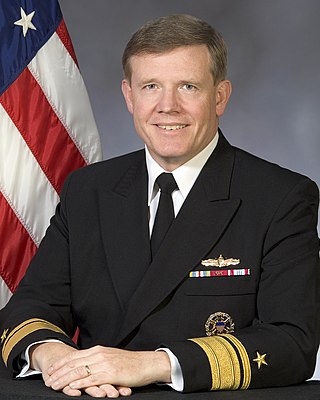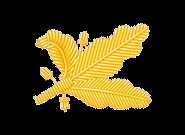The United States Armed Forces are the military forces of the United States. The armed forces consists of six service branches: the Army, Marine Corps, Navy, Air Force, Space Force, and Coast Guard. All six armed services are among the eight uniformed services of the United States.

The Air Force Materiel Command (AFMC) is a Major Command (MAJCOM) of the United States Air Force (USAF). AFMC was created on July 1, 1992, through the amalgamation of the former Air Force Logistics Command (AFLC) and the former Air Force Systems Command (AFSC).
In the United States Armed Forces, a line officer or officer of the line is a U.S. Navy or U.S. Marine Corps commissioned officer or warrant officer who exercises general command authority and is eligible for operational command positions, as opposed to officers who normally exercise command authority only within a Navy Staff Corps. The term line officer is also used by the U.S. Air Force and U.S. Coast Guard to indicate that an officer is eligible for command of operational, viz., tactical or combat units. The term is not generally used by officers of the U.S. Army – the roughly corresponding Army terms are basic branch and special branch qualified officers, although the concepts are not entirely synonymous, as some Army special branch officers are eligible to hold command outside their branch specialty.

The Transportation Corps is a combat service support branch of the U.S. Army. It is responsible for the movement of personnel and material by truck, rail, air, and sea. It is one of three U.S. Army logistics branches, the others being the Quartermaster Corps and the Ordnance Corps. The Corps was established in its current form on 31 July 1942, with predecessor services dating back to the American Civil War. The Transportation Corps is currently headquartered at Fort Gregg-Adams, Virginia. The officer in charge of the branch for doctrine, training, and professional development purposes is the Chief of Transportation (CoT) and Commandant of the US Army Transportation School, currently held by COL Beth A. Behn. The Corps's motto is "Nothing Happens Until Something Moves".

Marine Corps Logistics Base Albany is a United States Marine Corps base located just outside Albany, Georgia. The primary mission of the units on the base is to rebuild and repair ground combat and combat support equipment and to support installations on the East Coast of the United States. Today one of MCLB Albany's most important facilities is the Marine Corps Logistics Command's Maintenance Center. The only other facility of this kind is located at MCLB Albany's sister installation, Marine Corps Logistics Base Barstow, California. The base comprises more than 3,300 acres (13 km2) and in 2002 employed more than 2,400 civilians along with a complement of 600 Marines. One of the Corps' major commands, Marine Corps Logistics Command, is based at MCLB Albany. The command also encompasses activities at bases in Barstow, California, and Jacksonville, Florida.

The Indonesian Navy is the naval branch of the Indonesian National Armed Forces. It was founded on 10 September 1945 and has a role to patrol Indonesia's lengthy coastline, to enforce and patrol the territorial waters and Exclusive Economic Zone (EEZ) of Indonesia, to protect Indonesia's maritime strategic interests, to protect the islands surrounding Indonesia, and to defend against seaborne threats.
In the United States Marine Corps, a Marine Air–Ground Task Force is the principal organization for all missions across the range of military operations. MAGTFs are a balanced air–ground, combined arms task organization of Marine Corps forces under a single commander that is structured to accomplish a specific mission. The MAGTF was formalized by the publishing of Marine Corps Order 3120.3 in December 1963 "The Marine Corps in the National Defense, MCDP 1-0". It stated:

Rear Admiral Robert Dunham Reilly Jr. was a United States Navy Surface Warfare Flag Officer who retired from active duty in January 2010 after 34-plus years of military service. His last assignment was as the 24th commander of the U.S. Navy's Military Sealift Command (MSC).

The United States Marine Corps is organized within the Department of the Navy, which is led by the Secretary of the Navy (SECNAV). The most senior Marine commissioned officer is the Commandant of the Marine Corps, responsible for organizing, recruiting, training, and equipping the Marine Corps so that it is ready for operation under the command of the unified combatant commanders. The Marine Corps is organized into four principal subdivisions: Headquarters Marine Corps, the Operating Forces, the Supporting Establishment, and the Marine Forces Reserve.

Military organization or military organisation is the structuring of the armed forces of a state so as to offer such military capability as a national defense policy may require. In some countries, paramilitary forces are included in a nation's armed forces, though not considered military. Armed forces that are not a part of military or paramilitary organizations, such as insurgent forces, often emulate military organizations, or use these structures, while formal military organization tends to use hierarchical forms.

The Marine Corps Systems Command (MCSC) is the acquisition command of the United States Marine Corps, made up of Marines, sailors, civilians and contractors. As the only systems command in the Marine Corps, MCSC serves as Head of Contracting Authority and exercises technical authority for all Marine Corps ground weapon and information technology programs. MCSC is headquartered at Marine Corps Base Quantico.
The structure of the United States Navy consists of four main bodies: the Office of the Secretary of the Navy, the Office of the Chief of Naval Operations, the operating forces, and the Shore Establishment.

The term military medicine has a number of potential connotations. It may mean:

The Navy Supply Corps is the United States Navy staff corps concerned with supply, logistics, combat support, readiness, contracting, and fiscal matters.

The Naval Supply Systems Command (NAVSUP) serves as the supply command for the United States Navy for providing supplies, services, and support to both the Navy and the United States Marine Corps.

The logistics specialist (LS) is a US Navy enlisted rating that was created on 1 October, 2009 by the merger of the storekeeper (SK) and postal clerk (PC) ratings. It also included the previous functions of the former aviation storekeeper (AK) rating, which was previously merged into the former storekeeper (SK) rating on 1 January 2003.

A squadron in an air force, or naval or army aviation service, is a unit comprising a number of military aircraft and their aircrews, usually of the same type, typically with 12 to 24 aircraft, sometimes divided into three or four flights, depending on aircraft type and air force.

Naval Station Pascual Ledesma, also known as Cavite Naval Base or Cavite Navy Yard, is a military installation of the Philippine Navy in Cavite City. In the 1940s and '50s, it was called Philippine Navy Operating Base. The 9-hectare (22-acre) naval base is located at the easternmost end of Cavite Point in the San Roque district of the city. Via traffic lane, this naval establishment is next to the famous Samonte Park. It was the former extension of U.S. Naval Station Sangley Point which is now Naval Station Heracleo Alano. In 2009, it was named after Cmdre. Pascual Ledesma, a leader of the Philippine Revolution and the first Officer-In-Command of the Philippine Navy.













